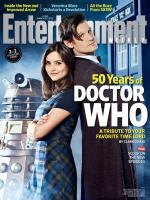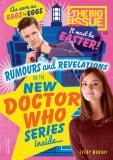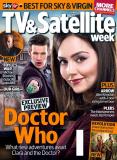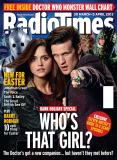A roundup of selected quotes from the media for the premiere of
The Bells of Saint John last night - links to the full review can be found via the author's name. You can also read our own review
here.
Please note that as these are reviews, spoilers may be present within the text!
The Guardian:
Moffat's writing is always hurtingly cutting-edge. This one was as if he'd sat in a dark pub for a while with Chris Morris and Charlie Brooker and analysed the Woefulness of Modern Stuff, yet somehow (as he ever is) been given a spoonful of kind honey on his way out. Oh, there were sillinesses. The other baddies were called Spoonheads because the backs of their heads look like … well, you have a guess. The great team of baddies was hiding out somewhere in London, which had been shot with many looming shots of the Shard, in somewhere which was obviously going to be high and rich with self-aggrandising uglyhood. But the complexity, the willingness to trust young brains, the actorly chemistry, and the team of writers coming up – Neil Gaiman, Mark Gatiss, the brilliant Neil Cross – prove that, eight years after it was reborn, it's a fine year to celebrate Doctor Who, possibly with a Pan Galactic Gargle Blaster but certainly with a nod to brilliant young children who grow up while still not forgetting what brilliant young children want.
(Euan Ferguson)The Guardian:
The Bells of Saint John is an episode defined by such little disappointments. Maybe it's because the scheduling this series has cranked things up to the point where everything is expected to be a showstopper. The Bells of Saint John makes a hearty meal of its iconic London locations – and some of them, like the sequence on the doomed aircraft, are fantastic. But after the tour de force that was The Snowmen, it feels as though this handsome episode constantly just misses the mark.
(Dan Martin)Radio Times:
The Bells of Saint John shows Steven Moffat at his confident, playful best – a hugely entertaining episode that revels in its modern London setting. He’s turned wi-fi and the worldwide web into targets of fear – tapping into contemporary anxieties and following in the Doctor Who tradition of mining menace from the mundane (shop-window dummies, gas masks, statues, our own body fat...).
The fast-paced action and quieter interludes are nicely judged by Colm McCarthy, directing his first Who. Murray Gold’s score is palpitating but unobtrusive. Moffat’s flights of fantasy (a diving airplane, the swivelling Spoonheads, the Doctor zooming up the Shard) are spotlessly realised by The Mill. In Cardiff they must be reeling at the news that the special effects house is closing down.
But most important is the chemistry between Jenna-Louise Coleman and Matt Smith. They look good together, they spark off each other, and let’s not forget this isn’t the first episode they filmed. Coleman is a natural: warm, sympathetic, gutsy, and surely destined to become one of the most popular companions. And Smith remains a joy to watch – note-perfect, nailing every scene, every moment.
(Patrick Mulkern)The Independent:
The Bells of Saint John felt unfulfilling as a standalone episode but perhaps I’m wrong to judge it so harshly. Perhaps this is only the beginning of the Doctor’s battle with the Great Intelligence yet as a self-contained episode I ended up feeling empty and cheated. In terms of functionality the story had to reintroduce Clara to the Doctor and create a bond between the pair anew which the audience has already witnessed twice before, so by the third time it felt rather tedious. For those keeping a death count, it appeared that soufflé girl briefly popped her clogs again this week when she was being uploaded.
Yet it wasn’t all doom and gloom, visually it was a great spectacle on a cinematic scale. The shots of London were a sight to behold as were the scenes inside the Shard between the Doctor and Miss Kizlet (Celia Imrie). It was just superb to see the Capital’s skyline in the background with the gherkin et al. on the horizon.
Overall the episode did not live up to the hype and left me feeling quite dismayed. I’m hoping that this is just a blip and that the rest of the series will be better. In fact I’m really looking forward to Hide, the ghost story episode set in a scary house starring Dougray Scott, because the one thing that Moffat does flawlessly is horror. The Weeping Angels, the clockwork droids in The Girl in the Fireplace and the people in gas masks asking ‘Are you my mummy?’ all came from the mind of Moffat. There is also a new villain ‘on par’ with the Weeping Angels that will be making its debut this year which has me intrigued.
(Neela Debnath)The Independent:
The story was curiously unambitious: a sinister plot to upload human souls via the internet to a virtual cloud. At one point, Matt Smith squared up to a humanoid with a satellite dish where the back of its head should have been, took a deep breath and said: "It's a walking Wi-Fi base station, hoovering up people!" Here and there, citizens were shown logging on and dropping off on trains, in bedrooms, sitting rooms like ... well, like the glass-eyed fictional viewers in the BBC's own recent promotional campaign promoting the virtues of watching its iPlayer device on the hoof.
Perhaps Steven Moffat and his team should focus their creative talents on the show itself. The pairing of an intellectually bright but emotionally dim male with a techno-illiterate but wised up female is a tired old trope of much drama and comedy, not just Doctor Who. It has been pointed out that there are no female writers of the show. There have also been rumours that Smith's days at the controls of the Tardis are numbered. Cue a female Doctor? About time.
(Mike Higgins)The Telegraph:
Viewers in search of thrills will certainly have relished The Bells of Saint John. Set in modern-day London, the plot concerned internet users who, if they clicked on the wrong wi-fi provider, found their souls being uploaded and their minds being harvested by a malevolent force. It was a witty, cautionary tale for anyone who has ever felt overwhelmed by the internet. This was Charlie Brooker’s Black Mirror for kids, a terrifying tale of information overload but without the grown-up, Dystopian despair.
Big-budget effects, a rapid pace, a sense of fun – there was much in The Bells of Saint John to enthral a 21st-century child. Yet, looking back over the 50 years of Doctor Who that led up to last night’s return, it’s hard to imagine children thrilling in quite the same way to some of the “vintage” episodes. Budgetary constraints aside, they would probably be left bemused by the theatrical configuration of scenes, the slow, even turgid plotting and the proliferation of technical dialogue.
(Ben Lawrence)The Mirror:
While The Bells of Saint John certainly had its moments, as a whole it didn't reach the heights of previous episodes. Arguably the two biggest set pieces of the episode (concerning a crashing plane and the Doctor driving up the side of the Shard on a motorbike) were impressive enough – you could even say Hollywood impressive. The only problem is that isn't much of compliment.
Yes, they were big and bold and doubtless expensive, but they felt shoe-horned in. Showy and a bit spectacle for spectacle's sake. Let's face it – Doctor Who has never been about Hollywood special effects, big bangs and crashing planes. From its humble beginnings to the present day, Who is at its most charming when it is at its most creaky, when its creativity is fully on show.
Who is the TV equivalent of comfort food. Apple crumble, onion gravy... a nice hunk of tangy, crumbling cheddar. The Bells of Saint John was more like nouvelle cuisine – flashy, expensive, but ultimately you needed a few more nibbles. Maybe some heartiness as well as a bit more heart would do the trick.
(Jon Cooper)SFX:
Surprisingly few Who stories locate their chills in the very place the audience interfaces with the programme but Moffat’s determined to mine the shiver-potential of mundane suburbia, tripping all its traditional mouse-traps for the imagination: the unexplained sounds from upstairs, the stranger at the door, the faceless figure beneath the streetlights. But there’s also a topical charge to this tale of something distinctly maggoty at the heart of our Apple-worshipping world. You can detect a definite touch of Black Mirror here, and while Moffat may not share Charlie Brooker’s culture-punching anger there are still some swift, stinging jabs at modern life, delicious pops at everything from surveillance cams to social networks to the ethics of the fast food industry (the show has rarely delivered as skewering a line as “The abbatoir [sic] is not a contradiction – no one loves cattle more than Burger King.” Now that’s taking names…).
(Nick Setchfield)Digital Spy:
The slick, striking opening to Doctor Who's 2013 debut 'The Bells of Saint John' immediately brings two things to mind - one, how far this show has come visually since its first big comeback in 2005. 'Bells' is expertly helmed by Who newbie Colm McCarthy, who's utilised time spent on location in London to impressive effect. It's all very well dressing up a street in Cardiff, but when you see those London landmarks, you just know where you are.
Packed full of action, intrigue and even a sort-of romance, 'The Bells of Saint John' sweeps the viewer along on a thrilling ride - 42 minutes has never shot by so quickly - and also provides plenty of juicy hints at what's to come in future weeks.
(Morgan Jeffery)Los Angeles Times:
I am perhaps not the most exacting critic of "Doctor Who." I watch it with a fan's desire to love everything and a willingness to blink when something I don't rears its head, or heads. I don't ask too many questions, even when they occur to me.
I might, for instance, wonder why the Doctor, when last seen, was sulkily holed up on top of a cloud in Victorian London, spurning all human requests for help. He had forever lost companions Amy and Rory Williams (collectively, the Ponds) at the end of the previous episode, it is true, but that is nothing new for him, being a thousand years old.
The answer, of course, is it gives the character somewhere to come back from, makes things feel more crucial — just as taking the Ponds to the edge of divorce (suddenly, if you didn't watch the Web mini-sodes that "explained" this, and pretty suddenly even if you did) made their love all the more palpable in the end. It also added poignancy to the Doctor's awakening interest in Clara, to whom he offered a key to his time machine before she was pulled from a cloud by a governess made of alien snowflakes and, for the time being, died.
(Robert Lloyd)Other reports::
Further reading:
The Express,
The Examiner,
Huffington Post,
Wall Street Journal,
Forbes,
Anglotopia,
EntertainmentWise,
Den of Geek,
Daily Mail The nominations for the 2013 Hugo Awards have now been announced, with writer Steven Moffat up against himself some three times in the Best Dramatic Presentation, Short Form category (in which he lost out last year to fellow writer Neil Gaiman for The Doctor's Wife).
The nominations for the 2013 Hugo Awards have now been announced, with writer Steven Moffat up against himself some three times in the Best Dramatic Presentation, Short Form category (in which he lost out last year to fellow writer Neil Gaiman for The Doctor's Wife).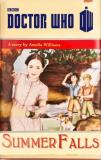

 DWM also reports that international film star
DWM also reports that international film star  Seemingly immortal, 50-years-old and still running, this engaging, imaginative sci-fi/fantasy series is awarded an Institutional Peabody for evolving with technology and the times like nothing else in the known television universe.
Seemingly immortal, 50-years-old and still running, this engaging, imaginative sci-fi/fantasy series is awarded an Institutional Peabody for evolving with technology and the times like nothing else in the known television universe.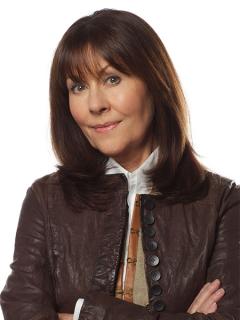 The Amazon-based LOVEFiLM streaming service will be making episodes of The Sarah Jane Adventures available to watch, as a new deal has been struck with BBC Worldwide. The package will include shows like The Story of Tracy Beaker, Balamory and Teletubbies.
The Amazon-based LOVEFiLM streaming service will be making episodes of The Sarah Jane Adventures available to watch, as a new deal has been struck with BBC Worldwide. The package will include shows like The Story of Tracy Beaker, Balamory and Teletubbies.
